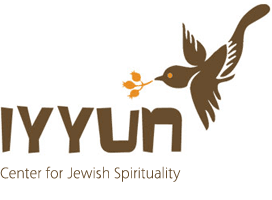The Sefer Yetzirah, among other texts, reveals a constellation of unique energies, themes, and spiritual practices, for each month of the year. We will build on these teachings in order to discover some of the deeper meanings of the Month of Nisan, and its special days, in particular the holiday of Passover or Pesach. This will help us unleash the redemptive powers of these most auspicious times.
Letter-Combination of the Month: YHVH
There are four letters in the name of Hashem (Yud, Hei, Vav, and Hei). Each month of the year has an inner light that is refracted as a different sequence of these four letters. The Month of Nisan shines as the original sequence: Yud–Hei–Vav–Hei.The letters Yud and Vav are called mashpi’im, or ‘givers’, and the letter Hei is called a m’kabeil, or ‘receiver’. This month’s sequence thus represents the proper flow of energy: if it were written vertically, the Yud would be on top giving to the Hei below it, and the Vav would be giving to the Hei at the bottom.
This sequence of letters is found in the beginnings of four words in Tehillim, 90:11 — Yismechu Hashamayim V’sageil Ha’aretz, “the Heavens will be happy and the earth will rejoice.†The nouns in this verse also allude to a flow from a giver above to a receiver below, shamayim (Heavens), giving to aretz (earth).
The verbs in this verse also describe an energetic flow. First comes yismechu (from the word simcha, ‘happiness’ ) and then comes v’sageil (from the word gila, ‘rejoicing’). Simcha has the same letters as mach’shava, ‘thought’, suggesting that yismechu refers to an inner joy, hidden within the mind. Gila is related to the word gilu, ‘to reveal’, suggesting that v’sageil refers to a form of joy that is expressed outwardly, in the world.1
Our letter-sequence therefore suggests a flow from giver to receiver, from above to below, from Heaven to earth, from inside to outside, and from hidden to revealed. In Nisan, we meditate on Hashem as the giver, and ourselves as the receivers.
Nisan is called the Month of Miracles. On Pesach, Hashem displays transcendental miracles, and descends, so to speak, to take us out of our lowliness and slavery. This is called an ‘awakening from above’, for it is an unearned gift of kindness flowing down to us from Heaven. During the Seder, the joy of freedom that has been suppressed and hidden deep within us is released. As we sing Hallel, we reveal our joy and gratitude openly.
Letter of the Month: Hei
The letter corresponding to Nisan is Hei. It is a ‘silent letter’, thus connected with the idea of ‘rest’. The lower Hei in Hashem’s name symbolizes the type of rest that manifests with each Shemita year. During a Shemita year, the earth is given rest from planting and sowing. The upper Hei symbolizes the type of rest that manifests in Yovel, the Jubilee year. This is a higher level of rest, in which slaves are set free.
Hei is thus the ‘letter of freedom’, restful freedom from the slavery of egocentric consciousness. This freedom comes unearned and undeserved, like the miraculous gift of Spring following the long barren winter.
Hei is also the letter from which Creation emerged, as the Talmud says, B’Hei nivrah olam hazeh—‘With the letter Hei this world was created.’2 Hashem speaks the world into being: “Let there be light,†etc. Each of the letters of speech is an articulation of the simple outward flow of breath, which is the “hhh†sound of the letter Hei. Therefore, the letter Hei is at the root of Hashem’s ‘creative process’. The power of Hei also allows us human beings to create. For example, when Avraham and Sarah added the letter Hei to their names, AvraHam and SaraH, they miraculously gave birth to their children after long being barren.
During the week of Pesach we ‘rest’ from eating chametz, leavened foods representing egocentrism. The word chametz and the word matzah each contain three letters. They share two of these letters (Mem and Tzadik). The differing letters are the Ches in chametz and the Hei in matzah. There’s only a tiny difference between a Hei and a Ches in their graphic design: the left leg of Hei is suspended in mid air, whereas the left leg of Ches rises up to the top. The empty gap in Hei represents humility, and an openness to receive. The closed gap in Ches represents arrogance or ego. When we abstain from ego, like Abraham and Sarah we can open to receive the mystical Hei, the ‘letter of miracles’, into our ‘name’, into our identity.
Name of the Month: Nisan/Aviv
Prior to the Babylonian exile, Nisan was called Chodesh haAviv, ‘the Month of Spring’. Aviv begins with the letters Aleph and Beis—the first and second letters of the alphabet—and then Yud, symbolizing Hashem. This spelling seems to say, ‘From above to below is the flow from Hashem.’
Rabbeinu Bachya breaks the word Aviv down and interprets it to mean av, ‘the father of’, iv or Yud-Beis. Yud-Beis is the number 12, signifying the twelve months of the year. In other words, Nisan is the father, the source, of the twelve months of the year.3
While Nisan is the beginning of ‘the year of months’, Tishrei is the beginning of ‘the year of days’. Tishrei is spelled Tav-Shin-Reish, which is the last three letters of the alphabet in reverse order, and then Yud, again symbolizing Hashem. This tells us that Tishrei is about a movement from below to above, the opposite of Nisan. Tishrei has the first day of what we normally consider the Jewish year: Rosh Hashana, the headquarters of shanah, linear ‘time’. Shanah is related to the word yashan, which means ‘old’, or routine. On the other hand, Nisan, the first chodesh or ‘month’, is the headquarters of chadash, ‘newness’. The moon is renewed every monthly cycle, breaking the monotony of linear time with a sense of the miraculous newness of life.
Only after the Babylonian exile, has this month been called Nisan. There is an argument over the source of the current names of the months.4 Are they originally from the Torah, are they Hebrew names that were lost over history and then rediscovered, or are they names that we borrowed from our hosts in Babylon? If the name Nisan has a Hebrew source, the source is the root word nes, meaning ‘miracle’. It is by definition the month of miracles. If, however, Nisan has a source in another cultures, then it comes from the Akkadian word nissanu, meaning ‘to move’ or ‘to start’. In Nisan, Hashem inspires us with miracles, and moves us to start anew.
Sense of the Month: Speech
The ‘sense’ or faculty corresponding to Nisan is speech. Just as Hashem created the world with speech, so do we create our world, or at least our experience of the world, with speech. A slave is someone who has no voice, nor the power to create his or her reality. We can only experience freedom when we can refer to ourselves as free. The word Haggadah means ‘telling’. During the Seder we speak at length about our Redemption from collective and personal ‘slavery’. Thus, each year we receive the ability to proclaim our freedom on higher and higher levels.
Astrological Sign of the Month: Taleh/Aries
The sign of Nisan is Taleh, the ‘lamb’, or Aries. In Nisan, Hashem took us, like a flock of lambs, out of the nation of our oppressors. We were meek, not yet desiring our freedom. Hashem leapt over the whole issue of our egos, and offered us Redemption. We were commanded to commemorate this Redemption with the Pesach offering, which was a lamb. Even if we have been meek or ambivalent about our freedom, on Pesach we can offer ourselves up to the experience of Redemption.
Tribe of the Month: Yehudah
Nisan is connected to the tribe of Yehudah. The meaning of the name Yehudah is ‘to give thanks’,5 alluding to speech. The archetype of kingship, King David, is a descendant of Yehudah. Kingship also alludes to speech, for a king rules over his people through his words, which are received as commands: “…for the word of the king is his rule.”6 The Talmud says that Nisan initiates the “New Year of Kingsâ€.7 It is thus a new beginning for the power of leadership, for speech, and also for expressing thanks. Because of the Redemption in this month, “…it is our duty to thank, laud praise, glorify, exalt, adore, bless, elevate, and honor the One who did all these miracles for our ancestors and for us.â€8
Body Part of the Month: Right Foot
The body part of Nisan is the right foot, representing chesed, ‘loving-kindness’. Pesach is connected with chesed. One meaning of the word Pesach is ‘loving’.9
Another meaning of the word Pesach is ‘to skip’, since Hashem skipped over the homes of the Jews during the Plague of the First Born. A person skips by using one foot at a time. This alludes to the miraculous, since normal walking uses both feet.
Time of the Year: Spring
Nisan is the first month of Spring. When it arrives, something about the increasing light, the warmer air, and the sprouting vegetation, may enhance our feeling that life is a gift and a blessing. Deeper within this instinctual feeling is the recognition that life is given to us whether we ‘deserve’ it or not. This is a deep level of humility, and it brings forth a tremendous sense of gratitude. During the eight days of Pesach, as we eat matzah, the bread of humility, we should strive to internalize this idea. Life is a miraculous gift descending from above. It cannot be earned, only humbly received. According to one opinion, Nisan is when human life was created.
The Torah calls Pesach Shabbas, ‘Sabbath’.10 The nature of the weekly Shabbas is that comes on it’s own, entirely without our involvement. The other holidays are created with some measure of human collaboration.11 Pesach is a gift of awakening from above.
This Pesach season, may we experience the newness and freshness of life. May this year be a year of creativity and generosity and new beginnings. May we become leaders, humble and kind leaders, who ‘skip over’ the apparent ego in others. May Hashem bless us to witness the beginning of the miracle of all miracles, the Redemption of all humanity from all levels of slavery.
- The Maggid of Mezritch, Imrei Tzadikim, p. 65 ↩
- Tractate Menachos, 29b ↩
- Rabbeinu Bachya on Shemos, 13:4 ↩
- “The names of the months came up from Babylon with us.” Yerushalmi, Rosh Hashanah, 1:2; See Ramban on Shemos, 12:2. Bnei Yissaschar. Chodesh Nissan. Maamor 1:6 ↩
- Bereishis, 29:35 ↩
- Koheles, 8:4 ↩
- Rosh HaShanah, 2a ↩
- The Haggadah of Pesach ↩
- Shemos, 12:23 ↩
- Vayikra 23:15, “Count the Omer from the day after Shabbas.†↩
- We are given the responsibility to establish when exactly the New Moon has occurred, and the New Moon determines when the Yom Tov of that month will occur. ↩







